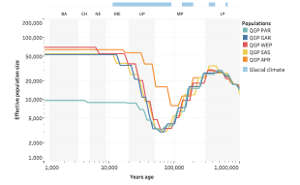The state of smart cities in MENA
11 December 2025
Published online 21 October 2021
Ancestry study tells the history of migrations and shapes the first genetic reference panel dedicated to Middle Eastern populations.

Department of Human Genetics, Sidra Medicine, Qatar Foundation, Doha, Qatar
Enlarge image
The Middle East is a historic crossroads of human civilizations, yet the genetic flow and structure of Arab people are largely understudied. Also, the relationship between modern Arabs and the early founders of the ancient Middle East is still unclear.
An international team, led by researchers from Sidra Medicine, Qatar, analysed more than 6,000 whole genomes – a dataset from the first phase of the Qatar Genome Program (QGP) – and found six genetic ancestries, which overlap with those from the populations of the wider Middle Eastern region.
“We were surprised to see such a high diversity in genetic ancestry. This makes the population of the small country of Qatar an excellent proxy for the Arab world. Population genetics discoveries from Qatar could apply to millions of Arabs everywhere,” says head of Sidra’s Medical and Population Genomics Lab, Younes Mokrab, who led the study together with Khalid A. Fakhro.
By comparing modern genomes with ancient human DNA dating back to the Palaeolithic and Neolithic periods, the researchers found that ancestors of Peninsular Arabs – one of the six genetic ancestries – migrated out of Africa and populated the Levant and various parts of Arabia. Peninsular Arabs were also the closest relatives to Neolithic farmers and hunter-gatherers who occupied the ancient Middle East around 12-20,000 years ago.
The researchers used the data to build a reference panel dedicated to Arab populations, which can be used to profile ancestries from a small number of key genetic markers, without having to sequence the entire genome from scratch. They also looked for genetic components associated with consanguinity, which was widespread in the ancient tribes and is related to disease susceptibility unique to people with Middle Eastern ancestry.
“These findings are of great significance because whole genome data were lacking in this region and will be beneficial to search for causal variants of diseases. Hopefully, when data from the Saudi Human Genome project is added to the present Qatari data in the near future, we can understand the genetic structures in the Middle Eastern region more comprehensively,” says molecular biologist Takashi Gojobori from King Abdullah University of Science and Technology (KAUST), Saudi Arabia, who was not involved in the study.
doi:10.1038/nmiddleeast.2021.84
Razali, R. M. et al. Thousands of Qatari genomes inform human migration history and improve imputation of Arab haplotypes. Nat. Commun. 12, 5929 (2021).
Stay connected: